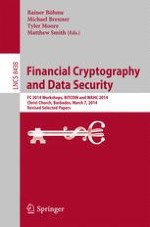This books constitutes the thoroughly refereed papers and poster abstracts from the FC 2014 Workshops, the First Workshop on Bitcoin Research, BITCOIN 2014, and the Second Workshop on Applied Homomorphic Cryptography and Encrypted Computing, WAHC 2014, co-located with the 18th International Conference on Financial Cryptography and Data Security, held in Christ Church, Barbados, on March 7, 2014. The 15 full papers and 3 poster abstracts presented were carefully reviewed and selected from 30 submissions. They are grouped in topical sections on Bitcoin transactions, policy and legal issues; Bitcoin security; improving digital currencies; posters, and WAHC papers.
